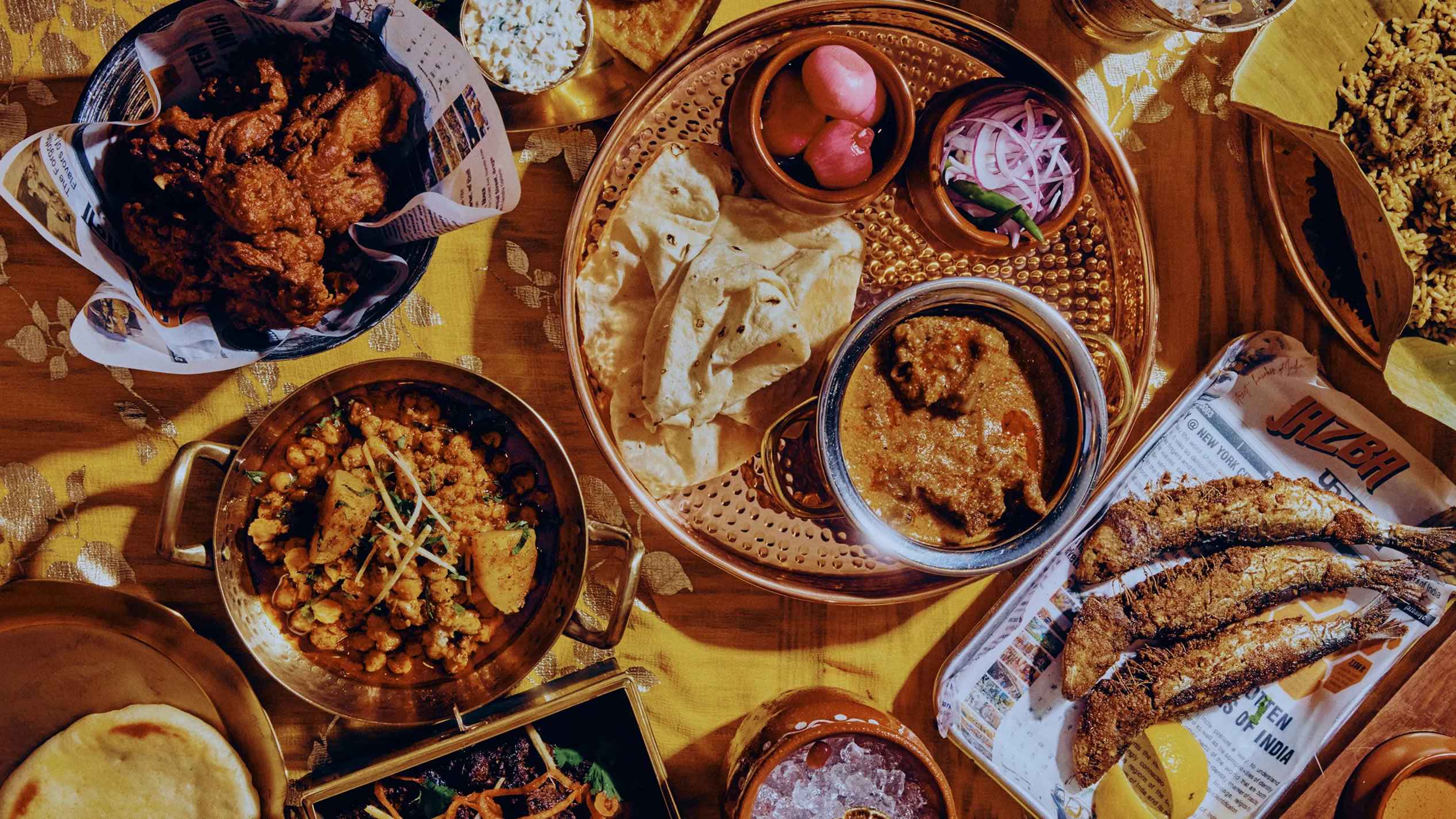New York City is a melting pot of cultures, and its culinary scene is no exception. Among the myriad of flavors and cuisines that grace the city, the vibrant and diverse thali culture stands out, offering a unique dining experience that encapsulates the essence of traditional Indian cuisine. This article explores the multifaceted world of thali, delving into its components, varieties, and the best places in New York to savor this delightful meal.
What is a Thali?
A thali is more than just a meal; it is a representation of Indian culture and hospitality. Traditionally served on a large platter, a thali includes a variety of dishes that reflect the diverse culinary landscape of India. Each component of the thali tells a story, showcasing regional ingredients, cooking techniques, and flavors. The cultural significance of thali dining is immense, as it promotes communal eating and sharing, making it a perfect choice for family gatherings and celebrations.
The Components of a Traditional Thali
A traditional thali is a symphony of flavors and textures, designed to provide a wholesome dining experience. At its core, a thali typically includes:
- Curry Dishes: A selection of vegetarian and/or non-vegetarian curries that vary by region.
- Breads: Flatbreads such as naan or roti that serve as the perfect accompaniment.
- Rice: Usually served plain or with spices, rice is a staple that complements the curries.
- Condiments: Pickles, yogurt, and chutneys add an extra layer of flavor.
- Dessert: A sweet dish to round off the meal.
This variety not only showcases the diversity of Indian cuisine but also provides a balanced meal, rich in nutrients and flavors.
Popular Thali Varieties in New York
New York boasts a rich selection of thali varieties, each offering a unique taste of India. Here are some of the most popular options:
North Indian Thali
The North Indian thali is known for its rich and robust flavors. Typically, it includes dishes like paneer butter masala, dal makhani, and chole, accompanied by naan or paratha. The use of spices such as cumin, coriander, and garam masala elevates the flavors, making it a favorite among many. In New York, restaurants like Dhaba and Indian Accent are renowned for their authentic North Indian thali offerings.
South Indian Thali
In contrast, a South Indian thali features a lighter fare, often consisting of dishes like sambar, rasam, and a variety of vegetable curries. Served with steamed rice and papadam, this thali is a celebration of spices like mustard seeds, curry leaves, and tamarind. To experience an authentic South Indian thali, head to Chennai Garden or Udupi Palace in New York.
Where to Find the Best Thali in New York
New York City is home to numerous Indian restaurants that pride themselves on serving authentic thalis. Some neighborhoods are particularly known for their vibrant Indian cuisine scene:
- Jackson Heights: This bustling neighborhood in Queens is often referred to as the heart of Indian cuisine in NYC, featuring a plethora of restaurants offering a variety of thalis.
- East Village: Known for its eclectic mix of eateries, the East Village is home to several Indian restaurants that serve delicious thali options.
- Midtown: With many Indian restaurants catering to the lunch crowd, Midtown offers quick and authentic thali experiences.
Online reviews and platforms like Yelp and TripAdvisor can provide valuable insights into the best thali experiences, helping diners make informed choices.
The Cultural Significance of Thali Dining
Thali dining is not merely about enjoying a meal; it is steeped in cultural significance. Sharing a thali fosters a sense of community and togetherness, embodying the essence of Indian hospitality. During festivals, thalis take center stage, featuring special dishes that vary according to the occasion. For instance, during Diwali, it is common to find sweets and festive dishes included in the thali, symbolizing joy and celebration.
In conclusion, the thali culture in New York is a vibrant tapestry of flavors, traditions, and communal dining experiences. With its rich history and diverse offerings, thali dining invites everyone to partake in the celebration of Indian cuisine.
What is a Thali?
A thali is more than just a meal; it is a culinary experience that showcases the rich tapestry of Indian cuisine. Traditionally served on a large platter, a thali brings together a variety of dishes, each representing different flavors, textures, and cooking styles from across India. This communal dining experience is not only about nourishment but also about cultural significance and the celebration of diversity within Indian gastronomy.
In its essence, the thali is a reflection of India’s regional differences. From the spicy curries of the North to the tangy flavors of the South, each thali tells a story of its origin. It typically includes a combination of rice, bread, curries, dal (lentils), pickles, and desserts, all served in small portions. This allows diners to sample a wide range of dishes in one sitting, making it an ideal choice for those wanting to explore the complexity of Indian flavors.
The components of a thali can vary significantly based on the region it hails from. For example, a North Indian thali may feature butter chicken, paneer tikka, and naan, while a South Indian thali might include sambar, rasam, and idli. This diversity is a testament to the rich culinary heritage of India, where each state boasts its unique ingredients and cooking techniques.
Moreover, the presentation of a thali is often as important as the food itself. The vibrant colors of the dishes, the intricate designs of the platter, and the aromatic spices create a feast for the senses. Sharing a thali with family and friends is a common practice, emphasizing the importance of community and togetherness in Indian culture. This aspect of thali dining is deeply rooted in Indian hospitality, where guests are treated with the utmost respect and care.
In recent years, thali culture has gained popularity in urban centers like New York, where diverse Indian restaurants offer their unique interpretations of this traditional meal. Diners can experience authentic flavors and innovative presentations, making it easier to enjoy a taste of India without traveling far. As a result, thali has become a symbol of cultural exchange, allowing people from different backgrounds to appreciate the richness of Indian cuisine.
In summary, a thali is not just a meal; it’s a celebration of India’s culinary diversity, a representation of its rich cultural heritage, and an invitation to share and connect with others. Whether enjoyed at a family gathering or in a bustling restaurant, the thali continues to embody the essence of Indian dining.
The Components of a Traditional Thali
When it comes to experiencing authentic Indian cuisine, few meals can match the vibrancy and diversity of a traditional thali. This culinary delight offers a comprehensive representation of Indian flavors, textures, and ingredients, all served on a single platter. Each thali is a feast for the senses, showcasing the rich tapestry of regional cuisines across India. In this section, we will delve into the essential components that make up a traditional thali, emphasizing the harmonious blend of curries, breads, rice, and condiments.
A traditional thali is not just a meal; it is an experience that brings together a variety of dishes, each offering its own unique taste and aroma. The beauty of a thali lies in its diversity and the balance of flavors, which can range from spicy and tangy to sweet and savory. Here are the essential components that make up a complete thali:
- Curries: At the heart of every thali are the curries, which can be vegetarian or non-vegetarian. These dishes vary widely based on regional influences, with each curry offering a different flavor profile. From the creamy butter chicken of North India to the tangy sambar of South India, curries are crafted using a variety of spices and ingredients that reflect the local culture.
- Breads: No thali is complete without an assortment of breads, which serve as the perfect accompaniment to curries. Common types include naan, roti, and paratha, each with its own texture and flavor. These breads are typically made from whole wheat or refined flour and are often cooked in a traditional clay oven called a tandoor.
- Rice: Rice is a staple in many Indian households and plays a crucial role in a thali. It acts as a base for the curries and helps balance the meal. Different regions have their own styles of rice preparation, ranging from plain steamed rice to flavored varieties like jeera rice or biryani.
- Condiments: To enhance the flavors of the meal, thalis often include a variety of condiments, known as achar (pickles), raita (yogurt-based side dishes), and chutneys. These add an extra layer of flavor and texture, making each bite a delightful experience.
- Desserts: To conclude the meal on a sweet note, a traditional thali may feature a small portion of dessert, such as gulab jamun or kheer. These sweet treats are often rich and indulgent, providing the perfect balance to the savory dishes.
In summary, a traditional thali is a vibrant representation of Indian culture and culinary diversity. Each component plays a vital role in creating a balanced meal that is both satisfying and flavorful. Whether you are enjoying a thali at a restaurant or preparing one at home, understanding these components will enhance your appreciation for this beloved Indian dining tradition.
Curries in a Thali
are not just dishes; they are a celebration of India’s diverse culinary heritage. Each curry tells a story, reflecting the cultural nuances and regional flavors that make Indian cuisine so rich. This section delves into the various types of curries found in a thali, their regional variations, and their role in enhancing the overall dining experience.
Curries can be broadly categorized into vegetarian and non-vegetarian options, each offering a unique taste profile and cultural significance. Vegetarian curries, such as dal makhani and paneer butter masala, are staples in many Indian households. Dal makhani, made from black lentils and kidney beans, is slow-cooked to perfection, resulting in a creamy and flavorful dish that pairs beautifully with rice or bread. Paneer butter masala, on the other hand, features soft cubes of paneer in a rich tomato-based gravy, making it a favorite among both vegetarians and meat-eaters alike.
On the other side, non-vegetarian curries bring a different dimension to the thali experience. Dishes like chicken tikka masala and fish curry showcase the use of aromatic spices and cooking techniques that vary by region. Chicken tikka masala, with its marinated chicken pieces cooked in a spiced tomato sauce, is a global favorite. Meanwhile, fish curry, particularly popular in coastal regions, often incorporates coconut milk and tamarind, offering a tangy and creamy flavor that is hard to resist.
Regional variations of curries add another layer of complexity to the thali. In North India, curries tend to be richer and creamier, often featuring dairy products like ghee and cream. In contrast, South Indian curries are typically lighter, with a focus on fresh ingredients and spices like mustard seeds and curry leaves. For instance, a traditional South Indian curry might include sambar, a lentil-based vegetable stew, which is both nutritious and flavorful.
Furthermore, the use of spices in curries varies significantly across regions. Punjab is known for its bold flavors, utilizing spices like garam masala and cumin, while Kerala emphasizes the use of fresh coconut and curry leaves, resulting in a distinct taste. This diversity allows diners to experience a range of flavors and textures, making each thali a unique culinary journey.
Curries also play a crucial role in the overall experience of enjoying a thali. They not only provide a burst of flavor but also complement other components, such as breads and rice. The interplay of flavors between the curries and the accompaniments creates a harmonious meal that is both satisfying and memorable. Additionally, the communal nature of thali dining encourages sharing and tasting multiple dishes, enhancing the social aspect of the meal.
In conclusion, curries are indeed the heart of any thali, embodying the rich tapestry of Indian cuisine. Their variety, regional influences, and the way they enhance the overall dining experience make them an essential component of this traditional meal. Whether you are a fan of vegetarian dishes or prefer the robust flavors of non-vegetarian options, there is a curry for everyone to enjoy in a thali.
Vegetarian vs. Non-Vegetarian Curries
In the vibrant tapestry of Indian cuisine, the debate between vegetarian and non-vegetarian curries is both a culinary and cultural exploration. Each type of curry brings its own unique flavors, textures, and cultural significance, making them essential components of a thali. This section delves into the differences between these two categories, highlighting popular choices and their roles in Indian dining.
Understanding the Essence of Vegetarian Curries
Vegetarian curries are not merely an alternative; they are a celebration of diversity in ingredients and flavors. Commonly prepared with a variety of vegetables, legumes, and spices, these curries reflect the rich agricultural heritage of India. Popular vegetarian curries include:
- Paneer Butter Masala – A creamy dish featuring paneer (Indian cottage cheese) cooked in a rich tomato-based sauce.
- Chana Masala – A spicy curry made with chickpeas, often garnished with fresh cilantro.
- Baingan Bharta – Roasted and mashed eggplant cooked with spices, offering a smoky flavor.
Vegetarian curries are often celebrated during festivals and religious ceremonies, making them a staple in many households. They symbolize purity and are often associated with the principles of ahimsa (non-violence), which is a core tenet of many Indian philosophies.
The Allure of Non-Vegetarian Curries
Non-vegetarian curries, on the other hand, bring a different richness to the table, often showcasing regional specialties that highlight the diversity of Indian cuisine. Some popular non-vegetarian curries include:
- Butter Chicken – A world-renowned dish featuring tender chicken pieces in a creamy, spiced gravy.
- Rogan Josh – A flavorful lamb curry with origins in Kashmiri cuisine, known for its aromatic spices.
- Fish Curry – Varies by region, often made with coconut milk and tamarind, offering a tangy and savory profile.
These curries are often associated with communal dining and celebrations, embodying the spirit of sharing and hospitality that is at the heart of Indian culture. Non-vegetarian dishes are frequently featured in special occasions, showcasing the culinary prowess of family cooks.
Cultural Significance of Vegetarian and Non-Vegetarian Curries
The choice between vegetarian and non-vegetarian curries often reflects personal, cultural, and regional preferences. In many parts of India, vegetarianism is prevalent due to religious beliefs, while in coastal regions, non-vegetarian dishes are more common, highlighting the local availability of seafood.
Furthermore, both types of curries serve as a bridge between tradition and modernity. As Indian cuisine continues to evolve, chefs are experimenting with fusion recipes that combine elements from both vegetarian and non-vegetarian dishes, creating innovative offerings that appeal to a broader audience.
In conclusion, whether one prefers the fresh, vibrant flavors of vegetarian curries or the rich, hearty profiles of non-vegetarian options, both play a crucial role in the thali experience. They offer a glimpse into the diverse culinary landscape of India, showcasing not only the ingredients but also the cultural narratives that accompany each dish.
Regional Variations of Curries
India is a land of diversity, and this is vividly reflected in its culinary landscape, particularly in the realm of curries. Each region boasts its own unique approach to curry preparation, influenced by local ingredients, climate, and cultural traditions. This section delves into the various regional variations of curries found across India, highlighting how these differences enrich the thali experience in New York’s Indian restaurants.
North Indian Curries
North Indian curries are known for their rich and creamy textures, often featuring ingredients like yogurt, cream, and a variety of spices. Dishes such as Butter Chicken and Paneer Tikka Masala exemplify this style, characterized by their use of aromatic spices like garam masala, cumin, and coriander. These curries are typically served with naan or roti, adding to the indulgent experience of a North Indian thali. In New York, many Indian restaurants offer these classic dishes, allowing diners to savor the essence of North Indian cuisine.
South Indian Curries
In contrast, South Indian curries are often lighter and more tangy, frequently incorporating coconut milk and tamarind. Dishes like Fish Curry from Kerala or Sambar, a lentil-based vegetable stew, showcase the region’s emphasis on fresh ingredients and bold flavors. These curries are usually accompanied by rice or dosa, a fermented crepe made from rice batter. The unique flavor profiles of South Indian curries make them a must-try for those exploring thali options in New York’s diverse Indian dining scene.
Western Indian Curries
Western India, particularly the states of Gujarat and Maharashtra, offers curries that are often sweeter and spicier. The use of jaggery and a variety of spices creates a distinctive taste. Dishes like Dhansak and Misal Pav highlight the region’s culinary creativity. These curries are typically served with rice or bread, providing a balanced meal that reflects the agricultural bounty of the region. New York’s Indian restaurants often feature these curries, giving diners a taste of Western India’s unique flavors.
Eastern Indian Curries
Eastern India, particularly West Bengal, is renowned for its seafood curries, which often feature mustard oil and a variety of spices. Dishes such as Shorshe Ilish (Hilsa fish in mustard sauce) and Chingri Malai Curry (prawn curry with coconut milk) are perfect examples of this region’s culinary richness. These curries are typically served with steamed rice, making them a comforting choice for thali lovers. In New York, some Indian restaurants specialize in Eastern Indian cuisine, offering a delightful exploration of flavors.
Conclusion
Understanding the regional variations of curries not only enhances the thali experience but also showcases the incredible diversity of Indian cuisine available in New York. Each curry tells a story of its origin, reflecting the culture and traditions of its region. As you explore the thali offerings in New York’s Indian restaurants, take the time to appreciate the unique flavors and ingredients that each regional curry brings to the table.
Breads and Rice in a Thali
Breads and rice are integral components of a traditional Indian thali, providing a foundation upon which the vibrant flavors of various dishes can shine. Together, they create a harmonious balance that enhances the overall dining experience. In this section, we will explore the different types of breads, such as naan and roti, and the essential role of rice in complementing the meal.
Breads in Indian cuisine are not just a side; they are a crucial element that contributes to the meal’s texture and flavor. The most common types of bread served in a thali include:
- Naan: A soft, leavened bread that is traditionally cooked in a tandoor (clay oven). Naan can be enjoyed plain or flavored with garlic, butter, or herbs, making it a versatile accompaniment to rich curries.
- Roti: Also known as chapati, this unleavened flatbread is made from whole wheat flour and is typically cooked on a griddle. Roti is a staple in many households and is praised for its health benefits.
- Paratha: A layered or stuffed flatbread, parathas can be filled with various ingredients, such as potatoes, paneer, or spinach, offering a delightful twist to the traditional bread.
- Puri: A deep-fried bread that puffs up when cooked, puris are often served with curries or as part of special festive meals.
Each type of bread serves a unique purpose, allowing diners to scoop up curries and savor the diverse flavors that a thali offers. The act of tearing off a piece of bread and using it to gather up a bite of curry is central to the communal experience of enjoying a thali.
Rice is another essential staple that complements the various dishes in a thali. It acts as a neutral base that balances the spices and flavors of the curries. The most common types of rice served include:
- Steamed Basmati Rice: Known for its long grains and fragrant aroma, basmati rice is often served plain or with a drizzle of ghee. Its light texture pairs beautifully with rich gravies.
- Pulao: A spiced rice dish cooked with vegetables or meat, pulao adds an extra layer of flavor to the thali. It is often garnished with nuts and raisins, making it a festive addition.
- Jeera Rice: This fragrant cumin-flavored rice is a simple yet flavorful option that enhances the taste of accompanying dishes.
Rice also serves as a filling component, ensuring that diners leave satisfied. In many Indian households, rice is considered a comfort food, and its presence in a thali is a nod to the cultural significance of this staple.
The true beauty of a thali lies in the combination of breads and rice with various curries. The contrasting textures and flavors create a delightful experience for the palate. For instance, while a rich butter chicken pairs excellently with naan, a light vegetable curry might be best enjoyed with roti or steamed rice. This versatility allows diners to customize their experience according to their taste preferences.
Moreover, the practice of mixing and matching different components of a thali fosters a sense of community and sharing, which is at the heart of Indian dining culture. Whether enjoyed at home or in a restaurant, the act of sharing a thali brings people together, creating memorable moments over a meal.
Popular Thali Varieties in New York
New York City is a melting pot of cultures, and its culinary landscape reflects this diversity, particularly in its Indian cuisine. Among the many offerings, the thali stands out as a quintessential representation of Indian dining. A thali is not merely a meal but a culinary experience that brings together a variety of dishes, each representing different regions and flavors of India. This section will explore some of the most popular thali varieties available in New York, highlighting their unique characteristics and the best places to savor them.
The North Indian thali is renowned for its rich flavors and diverse array of dishes. Typically, a North Indian thali features staples such as dal makhani, paneer butter masala, and an assortment of breads like naan and roti. Accompanying these are fragrant basmati rice and a variety of pickles and chutneys that enhance the meal’s flavor profile.
In New York, several restaurants excel in serving authentic North Indian thalis. For instance, Indian Accent and Chote Nawab are popular choices among locals and tourists alike. These establishments not only offer a traditional thali experience but also incorporate modern culinary techniques to elevate the dishes. Diners can expect a feast that tantalizes the taste buds while providing a glimpse into the rich culinary heritage of North India.
Contrasting with its North Indian counterpart, the South Indian thali is celebrated for its unique blend of flavors and textures. A typical South Indian thali includes dishes like sambar, rasam, and a variety of vegetable curries. The meal is usually served with steamed rice, idli, or dosa, accompanied by coconut chutney and pickles.
In New York, restaurants such as Udupi Palace and Madras Mahal specialize in South Indian cuisine, offering thalis that reflect the region’s culinary diversity. These venues often emphasize vegetarian dishes, showcasing the vibrant use of spices and fresh ingredients that define South Indian cooking. Diners can enjoy a wholesome meal that not only satisfies hunger but also provides a cultural experience that transports them to the southern regions of India.
The Gujarati thali is a delightful combination of sweet and savory dishes, showcasing the culinary traditions of the western Indian state of Gujarat. A typical thali features items such as dal, khichdi, thepla, and a variety of vegetable preparations, often accompanied by chutneys and pickles. What sets the Gujarati thali apart is the inclusion of sweet elements like shrikhand or gajar halwa, creating a balanced meal that is both satisfying and unique.
In New York, Patel Brothers and Swagat Indian Cuisine are known for their authentic Gujarati thalis. These restaurants emphasize the use of traditional recipes and ingredients, ensuring that diners enjoy an authentic experience. The Gujarati thali is not just a meal; it’s a celebration of flavors that reflect the region’s rich agricultural heritage.
Rajasthani cuisine is characterized by its bold flavors and vibrant colors, and the Rajasthani thali is a perfect representation of this culinary tradition. A typical thali includes dishes like dal baati churma, gatte ki sabzi, and ker sangri, served with roti and rice. The use of spices and unique cooking methods brings out the rich flavors that are synonymous with Rajasthani food.
In New York, Rajasthani Thali at Chutney Masala offers an authentic taste of this regional cuisine. The restaurant focuses on preserving traditional recipes while providing a modern dining experience. Diners can expect a feast that not only fills the stomach but also delights the senses with its aromatic spices and colorful presentation.
In conclusion, New York’s thali offerings showcase the rich culinary diversity of India, allowing diners to experience the flavors and traditions of various regions. Whether you prefer the hearty North Indian thali, the refreshing South Indian thali, the sweet and savory Gujarati thali, or the bold Rajasthani thali, there is something for everyone to enjoy in this vibrant city.
North Indian Thali
The North Indian thali is a vibrant and colorful representation of the rich culinary heritage of the region. Characterized by a variety of dishes, each thali offers a unique experience that reflects the diverse flavors and ingredients available in North India. A typical North Indian thali is a feast for the senses, featuring a harmonious blend of spices, textures, and aromas that come together to create a memorable meal.
- Curries: The centerpiece of a North Indian thali is undoubtedly the curries. These can range from rich and creamy butter chicken to spicy and tangy chole (chickpeas). Each curry is crafted with a unique blend of spices, often including cumin, coriander, and garam masala, which are essential to North Indian cooking.
- Breads: Accompanying the curries are various types of bread, such as naan, roti, and paratha. Each type of bread serves a different purpose, whether it’s to scoop up the curries or to complement the meal with its distinct flavor.
- Rice: No thali is complete without rice, which serves as a base for the curries. Basmati rice, known for its fragrant aroma and fluffy texture, is a common choice in North Indian thalis.
- Condiments: To enhance the flavors of the dishes, a selection of condiments is provided. These may include pickles, yogurt, and chutneys, which add an extra layer of flavor and balance to the meal.
- Salad: A fresh salad, often made with cucumber, onions, and tomatoes, is included to provide a refreshing contrast to the rich and spicy dishes.
In New York, several restaurants specialize in serving authentic North Indian thalis, allowing locals and visitors alike to indulge in this culinary delight. Some popular spots include:
- Dhaba: Located in the East Village, Dhaba offers a traditional thali experience with a variety of vegetarian and non-vegetarian options, showcasing the best of North Indian cuisine.
- Indian Accent: Known for its modern take on Indian dishes, Indian Accent presents a thali that blends traditional flavors with contemporary presentation.
- Chote Nawab: This restaurant is famous for its elaborate thali that features an array of dishes, ensuring a fulfilling dining experience.
When searching for the best North Indian thali in New York, consider exploring neighborhoods like Jackson Heights and Curry Hill, where a concentration of Indian restaurants provides ample choices. Online platforms like Yelp and Google Reviews can also guide you to the most highly recommended spots, helping you to discover hidden gems and popular favorites alike.
In conclusion, the North Indian thali is more than just a meal; it’s an experience that encapsulates the essence of Indian culture and hospitality. With its rich flavors, diverse components, and communal dining style, it invites diners to savor the culinary traditions of North India right in the heart of New York City.
South Indian Thali
South Indian thalis are a culinary delight, showcasing a **unique blend of flavors and textures** that reflect the rich heritage of Southern India. Unlike other regional thalis, the South Indian thali is characterized by its use of rice as the staple, accompanied by a variety of **curries, chutneys, and side dishes**. This section delves into the typical dishes found in a South Indian thali and highlights the best places to experience them in New York.
- Rice: The foundation of any South Indian meal, typically served as steamed white rice or flavored varieties such as lemon rice or coconut rice.
- Curries: A variety of vegetarian and non-vegetarian curries, including sambar (a lentil-based vegetable stew), rasam (a tangy soup), and various vegetable curries that are often made with seasonal produce.
- Chutneys: Accompanying the main dishes, chutneys made from coconut, tomato, and mint provide a burst of flavor.
- Side Dishes: Commonly includes papadam (crispy lentil wafers) and pickles for an added crunch and zest.
- Desserts: Often concludes the meal with traditional sweets like payasam (a rice pudding) or mysore pak (a sweet made from gram flour).
The essence of a South Indian thali lies in its **diversity and balance**. Each component is thoughtfully prepared to complement the others, creating a harmonious dining experience. The use of spices like mustard seeds, curry leaves, and tamarind adds depth to the flavors, making each bite memorable.
In New York, several restaurants offer authentic South Indian thalis, allowing diners to indulge in this culinary experience. Some of the best places to enjoy South Indian thalis include:
| Restaurant Name | Location | Highlights |
|---|---|---|
| Udupi Palace | New York, NY | Famous for its authentic South Indian vegetarian thali. |
| Chennai Garden | New York, NY | Known for its flavorful sambar and traditional desserts. |
| Saravana Bhavan | New York, NY | Offers a variety of thali options, including vegan choices. |
When dining at these establishments, guests can expect not just a meal, but a **cultural experience** that embodies the spirit of South Indian hospitality. The communal nature of sharing a thali encourages conversations and connections, making it a perfect dining option for families and friends alike.
In conclusion, South Indian thalis are a celebration of flavors, textures, and culinary traditions. They provide an opportunity to explore the rich diversity of Indian cuisine right in the heart of New York. Whether you are a seasoned fan of South Indian food or a newcomer, indulging in a thali is an experience that promises to be both satisfying and memorable.
Where to Find the Best Thali in New York
New York City, a melting pot of cultures, is home to a vibrant Indian community that has introduced the authentic thali experience to food enthusiasts. With numerous Indian restaurants scattered across the city, each offering unique interpretations of this traditional meal, finding the best thali can be an exciting culinary adventure. This section serves as your guide to the top spots in New York where you can savor the rich flavors and diverse offerings of thali.
Exploring Iconic Neighborhoods for Thali
Certain neighborhoods in New York are renowned for their Indian cuisine, making them prime locations for thali lovers. Areas such as Jackson Heights in Queens, known for its bustling Indian markets and restaurants, offer a wide range of thali options. Here, you can find restaurants like Chennai Garden, which serves a delectable South Indian thali, featuring an assortment of curries, rice, and traditional accompaniments.
Another hotspot is East Village, which houses popular spots like Bhatti Indian Grill. This restaurant offers a North Indian thali that includes rich curries, naan, and a selection of pickles. The atmosphere is vibrant, making it a great place to enjoy a communal dining experience.
Online Reviews and Recommendations
In today’s digital age, online reviews play a crucial role in guiding food enthusiasts to the best dining experiences. Websites like Yelp and TripAdvisor provide valuable insights into the quality of thalis served at various restaurants. For instance, users often rave about the thali at Indian Accent, which is praised for its modern take on traditional dishes while maintaining authenticity.
Social media platforms, particularly Instagram, have also become vital in discovering hidden gems. Food bloggers and influencers frequently share their experiences, showcasing the vibrant colors and intricate presentations of thalis, which can entice others to visit. Engaging with these platforms can help you find the most recommended thali spots and even seasonal specials that may not be widely advertised.
Must-Try Restaurants for Authentic Thali
When it comes to thali, certain restaurants stand out for their dedication to authenticity and flavor. Tiffin Wallah, located on the Upper West Side, is celebrated for its South Indian thali, which features a variety of dishes served on a banana leaf, enhancing the traditional experience. Their thali includes sambar, rasam, and a selection of chutneys that are sure to delight your palate.
On the other hand, Gali, a popular spot in the Lower East Side, offers a unique twist on the traditional thali by incorporating flavors from different regions of India. Their thali is a fusion of North and South Indian dishes, providing diners with a comprehensive taste of Indian cuisine.
Exploring Seasonal and Festival Thalis
Many Indian restaurants in New York also celebrate cultural festivals by offering special thali menus. During Diwali, for example, you might find restaurants like Khao Noodle Shop featuring a festive thali that includes a variety of sweets, savory dishes, and seasonal specialties. These limited-time offerings not only enhance your dining experience but also provide insight into the cultural significance of thali during celebrations.
In conclusion, the quest for the best thali in New York is an enriching journey through the city’s diverse culinary landscape. By exploring iconic neighborhoods, leveraging online reviews, and trying out must-visit restaurants, you can immerse yourself in the flavors of India right in the heart of New York City.
Neighborhoods with Great Thali Options
New York City, a melting pot of cultures, offers a remarkable tapestry of culinary experiences, particularly for those seeking authentic Indian cuisine. Among the standout offerings is the traditional Indian thali, a meal that showcases a variety of dishes on a single platter. To truly savor the diverse flavors of thali, certain neighborhoods in New York have become renowned for their exceptional Indian restaurants. This section highlights these vibrant areas, guiding food enthusiasts on a culinary exploration of thali offerings.
- Jackson Heights, Queens: Known as the heart of South Asian culture in New York, Jackson Heights is a must-visit for thali lovers. The neighborhood is home to numerous Indian restaurants, each offering their unique take on thali. Here, you can find a variety of thali options, from North Indian to South Indian, that reflect the rich diversity of Indian cuisine. Popular spots like Dhaba and Utsav serve delicious thalis that include an array of curries, rice, and bread, making it an ideal destination for a culinary adventure.
- East Village, Manhattan: The East Village has become a hotspot for Indian dining, featuring a blend of traditional and contemporary Indian cuisine. Restaurants like Chote Nawab and Kati Roll Company offer thalis that are both authentic and innovative. The East Village’s vibrant atmosphere, coupled with its diverse culinary offerings, makes it a fantastic neighborhood to explore the rich flavors of Indian thali.
- Flushing, Queens: Flushing is another neighborhood that boasts a rich Indian culinary scene. Known for its bustling markets and diverse eateries, Flushing offers a range of thali options that cater to various palates. Restaurants such as Bhatti Indian Grill and Spice Symphony serve thalis that highlight the regional specialties of India, allowing diners to indulge in a delightful array of flavors.
- West 26th Street, Manhattan: This street has earned a reputation for its concentration of Indian restaurants, making it a prime location for thali exploration. Establishments like Indian Accent and Junoon present thalis that not only include traditional dishes but also incorporate modern culinary techniques. The fusion of flavors and presentation elevates the dining experience, making it a must-visit area for food enthusiasts.
- Richmond Hill, Queens: Richmond Hill is known for its strong Indian community and offers a plethora of restaurants that serve delectable thalis. The neighborhood is famous for its authentic flavors and generous portions. Restaurants like Roti Boti and Aangan are popular choices, where diners can enjoy a traditional thali that includes a variety of curries, breads, and sides, all served with a warm, welcoming atmosphere.
Exploring these neighborhoods not only allows you to indulge in a variety of thali offerings but also provides a glimpse into the vibrant Indian culture that thrives in New York City. Each area has its unique charm and culinary specialties, making them perfect destinations for both seasoned Indian cuisine enthusiasts and newcomers alike. Whether you are craving the rich flavors of North Indian thali or the spicy delights of South Indian fare, New York’s neighborhoods have something to satisfy every palate.
Online Reviews and Recommendations
When it comes to discovering the best thali experiences in New York, have become invaluable tools for food enthusiasts. In this digital age, platforms like Yelp, Google Reviews, and TripAdvisor offer a wealth of information that can help diners make informed choices about where to enjoy this traditional Indian meal. This section will explore how to effectively leverage these resources to find your perfect thali.
Online reviews play a crucial role in shaping our dining decisions. They provide insights from fellow diners, offering a glimpse into the quality and authenticity of the thali being served. Here are a few reasons why you should consider online reviews:
- Authenticity: Reviews often highlight whether a restaurant serves authentic regional thalis, helping you find the genuine flavors of India.
- Variety: Diners frequently share their experiences regarding the variety of dishes included in the thali, allowing you to gauge the richness of the meal.
- Service Quality: Feedback on service can be just as important as the food itself. Reviews can inform you about the level of hospitality and efficiency you can expect.
With numerous platforms available, knowing how to navigate them can enhance your search for the perfect thali. Here are some tips:
- Use Specific Keywords: When searching, use specific terms like “best North Indian thali” or “authentic South Indian thali” to narrow down your options.
- Filter by Ratings: Most review platforms allow you to filter results by ratings. Focus on restaurants with high ratings and a substantial number of reviews for a reliable choice.
- Read Recent Reviews: Recent reviews provide the most current information about a restaurant’s offerings and service. Look for mentions of any new dishes or recent changes in quality.
Not all reviews are created equal. Here’s what to pay attention to when reading through them:
- Descriptive Feedback: Look for reviews that describe the flavors, presentation, and portion sizes of the thali. Descriptive feedback can give you a better sense of what to expect.
- Photos: Many reviewers upload photos of their meals. Visuals can significantly aid in assessing whether the presentation aligns with your preferences.
- Common Complaints: While positive reviews are encouraging, it’s essential to note any recurring complaints. This can help you avoid potential disappointments.
Another effective way to enhance your thali dining experience is to engage with the local food community online. Join forums or social media groups dedicated to Indian cuisine in New York. Here, you can ask for personal recommendations, share your experiences, and even discover hidden gems that may not have a strong online presence. Engaging with fellow food lovers can provide you with unique insights and help you uncover the best thali spots in the city.
In conclusion, leveraging online reviews and recommendations is essential for any thali enthusiast looking to explore New York’s vibrant Indian dining scene. By utilizing the right platforms, focusing on descriptive feedback, and engaging with the food community, you can enhance your chances of finding a thali that not only satisfies your palate but also provides a memorable culinary experience.
The Cultural Significance of Thali Dining
Thali dining transcends mere sustenance; it encapsulates the essence of Indian culture and hospitality. This communal way of dining is a vivid reflection of India’s rich traditions and social values. Sharing a thali is not just about the food; it is an experience that fosters connections, celebrates diversity, and honors age-old customs.
In India, hospitality is a revered virtue, often expressed through food. A thali is more than a meal; it is a symbol of welcome. When guests arrive, offering them a thali signifies respect and warmth. This gesture of sharing food creates an inviting atmosphere, reflecting the Indian saying, “Atithi Devo Bhava,” which translates to “The guest is God.”
When dining on a thali, the act of sharing becomes paramount. Family and friends gather around a table, each person contributing to the meal by passing dishes and serving one another. This communal aspect fosters a sense of belonging and strengthens relationships. The variety of flavors and textures on a thali encourages conversation and engagement, making the dining experience lively and interactive.
Thali dining serves as a bridge between generations and communities. Each region in India boasts its own unique thali, showcasing local ingredients, culinary techniques, and traditions. For instance, a North Indian thali may feature rich curries and bread, while a South Indian thali emphasizes rice and lentils. This geographical diversity highlights the cultural mosaic of India.
Moreover, thali dining is often integral to celebrations and festivals. During occasions like Diwali or Holi, families prepare elaborate thalis filled with special dishes, symbolizing abundance and joy. These meals not only satisfy hunger but also create lasting memories, binding families and communities together through shared experiences.
As India embraces modernization, the traditional thali has also evolved. In urban centers like New York, thali dining has taken on new forms, blending traditional recipes with contemporary culinary trends. Restaurants now offer fusion thalis that incorporate international flavors, catering to diverse palates while still honoring the essence of Indian cuisine.
Despite these changes, the core values of thali dining remain intact. The emphasis on sharing and communal eating persists, allowing people from various backgrounds to come together over a meal. This adaptability of thali dining reflects the resilience of Indian culture, ensuring that its rich traditions continue to thrive in a globalized world.
Thali dining is a celebration of India’s vast culinary diversity. Each dish on a thali tells a story, representing the region it hails from. This variety not only tantalizes the taste buds but also educates diners about the cultural significance of each component. For example, the presence of pickles and chutneys on a thali speaks to the Indian love for balancing flavors, while the choice of lentils showcases the nutritional aspects of Indian cuisine.
Furthermore, thali dining encourages exploration and experimentation. Diners are often motivated to try new dishes they may not normally order, expanding their culinary horizons. This aspect of thali dining promotes cultural exchange, allowing individuals to appreciate the richness of Indian traditions while fostering a sense of curiosity and adventure in their culinary experiences.
In summary, thali dining is a profound cultural experience that goes beyond mere food consumption. It embodies the spirit of Indian hospitality, serves as a cultural connector, adapts to modern influences, and celebrates the diversity of Indian cuisine. The act of sharing a thali fosters connections and creates lasting memories, making it an integral part of India’s culinary heritage.
Thali as a Symbol of Indian Hospitality
Thali dining is more than just a meal; it is a rich tapestry woven with threads of culture, tradition, and community. In India, sharing food is a sacred ritual, and the thali epitomizes this essence of togetherness. It encourages communal eating, where family and friends gather around a table, sharing not only food but also stories, laughter, and love. This subsection delves deeper into how thali dining embodies the essence of Indian hospitality, fostering connections and creating lasting memories.
At the heart of Indian hospitality lies the principle of Atithi Devo Bhava, which translates to “The guest is God.” This philosophy is evident in the way meals are served, particularly in the context of thali dining. When guests are welcomed into a home, they are often presented with a thali, which is a symbol of abundance and generosity. The platter is filled with an array of dishes, each carefully prepared to showcase the host’s culinary skills and to honor the guests. This act of serving a thali is a way of expressing love and respect, making guests feel cherished and valued.
Thali dining transcends mere sustenance; it is an experience that emphasizes sharing. The various dishes on a thali are meant to be enjoyed together, encouraging diners to partake in a collective experience. Each person can sample different flavors, textures, and aromas, creating a sense of unity among those gathered. This communal aspect of thali dining fosters conversations and interactions, allowing people to bond over their shared love for food. It is not uncommon to see diners passing dishes around, serving each other, and discussing their preferences, which further enhances the sense of community.
Moreover, thali dining is often associated with celebrations and special occasions. During festivals, weddings, and family gatherings, the thali takes center stage, symbolizing abundance and prosperity. The variety of dishes served reflects the culinary diversity of India, with each region contributing its unique flavors and specialties. This not only showcases the richness of Indian cuisine but also highlights the importance of food in bringing people together during significant life events.
In addition to its role in fostering connections, thali dining also serves as a medium for cultural exchange. As people from different backgrounds come together to enjoy a thali, they share their stories, traditions, and experiences, enriching each other’s understanding of diverse cultures. This aspect of thali dining is particularly evident in multicultural settings, such as New York, where a melting pot of cultures exists. Here, thali dining becomes a bridge, connecting individuals from various walks of life through the universal language of food.
Ultimately, thali dining is a celebration of hospitality and community. It invites people to slow down, savor their meals, and appreciate the company of loved ones. Whether it is a casual family dinner or a grand festive gathering, the thali serves as a reminder of the importance of togetherness and the joy of sharing. In a world that often feels disconnected, thali dining offers a beautiful opportunity to reconnect with others, fostering bonds that can last a lifetime.
Celebrating Festivals with Thali
Thalis are a vibrant expression of Indian culture, especially during festivals, where the culinary offerings become a central part of the celebration. Festivals in India are not just about rituals and traditions; they are also a time for families to come together and share meals that are rich in flavor and symbolism. The diversity of Indian festivals influences thali offerings, making each celebration unique and culturally significant.
- Diwali: The Festival of Lights, Diwali, is celebrated with a grand feast that often includes a special thali. Traditional sweets like gulab jamun and barfi are commonly included, symbolizing the sweetness of life. The savory dishes may vary by region, but each thali reflects the joy and prosperity associated with the festival.
- Holi: Known as the Festival of Colors, Holi is celebrated with vibrant thalis filled with colorful dishes. The thali often features gujiya (a sweet dumpling), puran poli, and various savory snacks. The emphasis on sharing these meals enhances the spirit of togetherness and festivity.
- Eid: During Eid, thali offerings are often lavish, featuring rich biryanis, kebabs, and a variety of desserts. The communal aspect of sharing a thali during this festival emphasizes unity and gratitude, making it a significant ritual for many families.
- Pongal: In South India, Pongal is celebrated with a thali that includes the traditional dish of the same name, made from rice and lentils. The thali is often adorned with seasonal vegetables and sweets, highlighting the agricultural significance of the festival.
The importance of thali meals during festivals extends beyond mere sustenance. They serve as a medium for cultural expression, showcasing regional specialties and family recipes that have been passed down through generations. For instance, during Navratri, a festival dedicated to the worship of the goddess Durga, vegetarian thalis are prepared with a variety of dishes made from fresh produce, grains, and legumes. Each dish represents a different aspect of the goddess, and the meal itself becomes a form of reverence.
Moreover, the act of sharing a thali fosters a sense of community and belonging. Families and friends gather around the table, and the thali becomes a focal point for conversation and connection. In many households, the preparation of thali meals is a collaborative effort, involving multiple family members in the cooking process. This collective involvement not only strengthens familial bonds but also ensures that the traditions associated with each festival are upheld and cherished.
As Indian culture continues to spread globally, festivals celebrated with thali meals are being embraced by diverse communities. In places like New York, Indian restaurants often curate special thali menus during major festivals, allowing patrons to experience these rich traditions. This not only introduces the flavors of Indian cuisine to a wider audience but also preserves the cultural significance of thali dining.
In conclusion, thalis play an essential role in the celebration of Indian festivals, reflecting the rich tapestry of traditions, flavors, and communal spirit that characterize these occasions. Each festival brings its own unique thali offerings, making them a vital part of the cultural celebrations that define Indian heritage.














